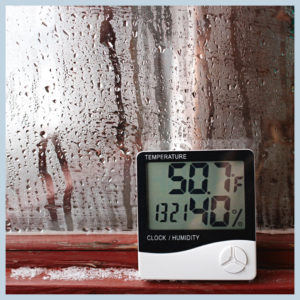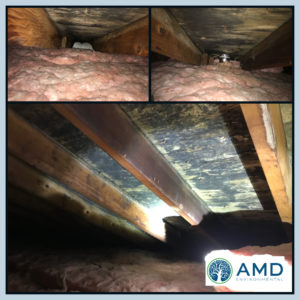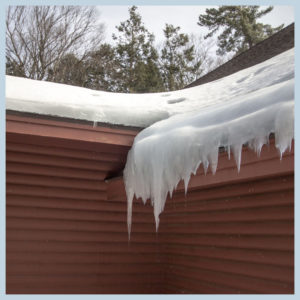Why Won’t My Mold Problem Go Away?
Mold problems can persist if the moisture problem is not under control.
Often, homeowners will call our mold assessors for help because they have a recurring problem with mold. Many have experienced continuous mold growth despite using the most potent mold prevention sprays on the market. These sprays claim to eradicate mold, clean it up, and prevent growth in the future.
After attempting to remove mold themselves, homeowners are usually surprised to find out their mold problem is still a problem. But why?
The more significant issue is moisture. Mold will continue to grow if you don’t fix the moisture problem or balance the relative humidity in your home.
What are common sources of moisture in a home?
Bathroom
 The bathroom is one of the moistest, wettest areas in the house. Mold thrives in damp areas near leaky pipes. Sometimes, leaky pipes go undetected because of a pin-size hole that slowly leaks over time or because clutter covers up the water damage under the sink. Leaky pipes are a common problem, especially in smaller spaces where people utilize all the space in the bathroom for storage.
The bathroom is one of the moistest, wettest areas in the house. Mold thrives in damp areas near leaky pipes. Sometimes, leaky pipes go undetected because of a pin-size hole that slowly leaks over time or because clutter covers up the water damage under the sink. Leaky pipes are a common problem, especially in smaller spaces where people utilize all the space in the bathroom for storage.
Not only should you check under the sink for water damage, but you should also wash out your toothbrush container regularly! Remember, mold spores need moisture to grow. If your toothbrush drips water into a ceramic or glass container, it’s only time before mold begins to grow. Yuck!
Behind Drywall
It’s hard to detect moisture behind your walls if you don’t have thermal imaging technology. Mold spores love to feed off organic substances, such as the compounds in drywall. A little moisture can go a long way for a mold spore to grow and multiply. We see this all the time – hidden sources of moisture in hard-to-detect places like walls fuel mold growth in a matter of days.
With every day that goes by and molds spreading, the potential threat to human health increases.
AMD Environmental Consultants’ mold assessors use advanced thermal imaging technology to detect moisture levels in the walls. Short of tearing down the walls, this is the best way to determine if a moisture problem exists in hidden places.
Windows
 Sweaty windows are an indication that there’s an issue with the relative humidity in a home. If the humidity in the home is too high, you’ll see condensation around the windows. This is what many people call “sweaty windows.” When the humidity is not balanced, structural damage may occur. But this isn’t the worst thing that can happen. Mold growth may result from relative humidity imbalances and harm a person’s health.
Sweaty windows are an indication that there’s an issue with the relative humidity in a home. If the humidity in the home is too high, you’ll see condensation around the windows. This is what many people call “sweaty windows.” When the humidity is not balanced, structural damage may occur. But this isn’t the worst thing that can happen. Mold growth may result from relative humidity imbalances and harm a person’s health.
Sometimes a dehumidifier is all it takes to balance the relative humidity, but if the problem goes unchecked, the condensation could be enough to support mold growth.
Cardboard Boxes
You are not alone if you store household or garage items in cardboard boxes. It makes sense, right? They are inexpensive, stackable, and cubed, so they fit against walls. The problem with this storage method is that cardboard is made of paper, and mold loves to feed off organic compounds. If the boxes get wet or in high humidity, they become a haven for mold growth. Mold spores need moisture to start the feeding frenzy.
One suggestion is to separate the boxes in the storage area.
It might even be better to store items in plastic bins with airtight lids.
Roof Leaks
 Put on your detective hat and start investigating. Roof leaks are not always obvious, but you can identify potential problems before they start.
Put on your detective hat and start investigating. Roof leaks are not always obvious, but you can identify potential problems before they start.
One way to find leaks (or head them off) is to check your roof for missing or damaged shingles. Walk your property often to inspect your home, especially after a windy day or storm.
 Depending on where you live, ice dams are a huge concern and can cause damage to your roof. Ice dams can occur in the cold months if your home is underventilated.
Depending on where you live, ice dams are a huge concern and can cause damage to your roof. Ice dams can occur in the cold months if your home is underventilated.
Ice damming occurs when hot air moves into the attic, and the house can’t get rid of the heat. The ice builds up on the eave of a slanted roof because the snow underneath melts. The meltwater flows down the roof until it reaches a point where there is no longer heat from the home. The meltwater freezes and forms a dam. This can cause structural damage to the roof and a leak inside the house.
Sealing up air leaks into the attic is an excellent way to prevent ice dams from building up. Think of it like this: tight construction is good – underventilated is bad.
Be on the lookout for wet spots on the ceiling, and check your attic for water damage signs.
Who should I contact for help?
AMD Environmental can help you identify sources of moisture or relative humidity imbalances in your home. Until then, mold may continue to grow despite your best efforts to rid your home of this pesky fungus.

